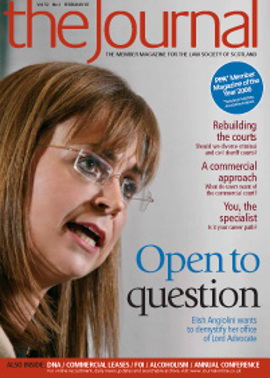Book reviews

Andrew C Ferguson
PUBLISHER: AVIZANDUM PUBLISHING LTD
ISBN: 1 904 968 09 0
PRICE: £27
A conveyancing or property law problem concerning common good law is perhaps not one which is likely to feature in the daily life of a solicitor in private practice. Nevertheless it is surprising just how often issues relating to the right of a local authority to dispose of its own property do arise.
Common good law issues therefore are not just for local authority lawyers. Issues are very often raised by members of the public, be they members of a community council or simply people who have been accustomed to walk their dogs over a particular area of ground owned by the local authority. However solicitors engaged in commercial property transactions must also take account of common good law if, for example, they are acting for a development company which is acquiring a former town hall (cf Magistrates of Kirkcaldy v Marks & Spencer 1937 SLT 574).
Common good arose as a concept centuries ago and it was used to distinguish between the property owned by a burgh for the benefit of the inhabitants and property owned by individual burgesses. If buying from a local authority it is important to know whether the property concerned can be said to be part of the common good. If it is, it is even more important to know whether it is to be regarded as inalienable or alienable. This is a particularly tricky area of the law, and although s 75 of the Local Government (Scotland) Act 1973 allows a local authority to petition the court for consent to dispose of common good land, this only applies where a question “arises” as to the alienability of the property. The safest course is for a local authority to petition, but there is no guarantee that a court will actually grant consent
(see, e.g. West Dunbartonshire Council v Harvie 1997 SLT 979 (OH); 1998 SC 789 (IH)).
When looking at my index of opinions I was surprised to see how many had actually been requested in relation to common good issues. I was even more surprised to find that the instructing parties were not always local authorities. I have found Andrew Ferguson’s book to be an invaluable guide to this tricky but nonetheless very interesting area of law. The treatment is full yet concise and the book is well written. There are chapters on the origins and definitions of common good, and the statutory controls, beginning with the Common Good Act 1491 and ending with the Abolition of Feudal Tenure etc (Scotland) Act 2000. The treatment of the distinction between inalienable and alienable common good land is particularly well thought out. All the important cases are referred to and, where this can be done, compared and reconciled. In fairness, as the author admits, not all the cases can be reconciled.
One of the interesting aspects of common good law relates to the interpretation of grants of land to local authorities, especially by public-spirited benefactors. It is sometimes difficult to distinguish between a conveyance to a local authority as trustee for the inhabitants of a local authority area and a conveyance of property to the local authority generally for behoof of the community. The former may create a public trust, whereas the latter conveys the property to the local authority as common good land. Ferguson deals with this difficult issue at considerable length and in a clear manner in chapter 5.
This book is not simply a theoretical discourse on an obscure area of law. In chapter 6 the author deals with appropriation, alienation and disposal of common good land, and in chapters 8 and 9 the mechanics of bringing a s 75 petition to the court. Finally, the author is not afraid to admit that there are some unanswered questions in relation to common good law in the 21st century. I am always frankly suspicious of lawyers (be they academic or practising) who appear to have the view that every question can be or indeed has been answered by them in a book or article. In chapter 10 Ferguson points out that common good has been a controversial topic from the earliest reported cases. As he accepts, it is almost bound to raise political and social as well as legal issues as where, for example, a local authority wants to release land for the erection of a school the cost of which is to be financed through the public private partnership scheme
(South Lanarkshire Council, Petrs, IH, 11 August 2004, unreported).
No legal department of any local authority should be without this book, but neither should any firm of solicitors likely to be involved in the acquisition of local authority land or buildings.
Robert Rennie
In this issue
- Routes to qualification: the Italian picture
- Speaking of change
- Disabled from suing?
- Hearing and answering
- Court afresh
- Clean sheet at the Commercial Court
- Making a specialism pay
- LCN DNA - devil in the detail
- To buy or not to buy?
- Just a winter warmer?
- Views from the new boy
- Working out time
- A claim in trust
- Incapable of dismissal?
- Chasing debts made simple?
- Scottish Solicitors' Discipline Tribunal
- Website reviews
- Book reviews
- FOISA goes to court
- On the wrong track?






